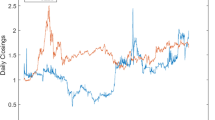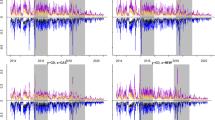Abstract
Influenced by the global economy, politics, energy and other factors, the price of carbon market fluctuates sharply. It is of great practical significance to explore a suitable measurement method of extreme risk of carbon market. Considering that the return series of carbon market has the characteristics of leptokurtosis, fat tail, skewness and multifractal, and there maybe many extreme risk values in the carbon market, this paper introduces the Skewed-t distribution which can describe the characteristics of leptokurtosis, fat tail and skewness of return series into MSM model which can describe multifractal characteristic of return series to model volatility of carbon market. On the basis, based on the extreme value theory, this paper constructs Skewed-t-MSM-EVT model to measure extreme risk of carbon market. This paper chooses EUA market as the object to study extreme risk of carbon market, and draws the following conclusions: Skewed-t-MSM-EVT model has significantly higher prediction accuracy for carbon market’s VaR than MSM-EVT models under other distributions (including normal distribution, t distribution, GED distribution); Skewed-t-MSM-EVT model is superior to traditional Skewed-t-FIGARCH-EVT and Skewed-t-GARCH-EVT models in predicting carbon market’s VaR. This research has important practical significance for accurately grasping the risk of carbon market and promoting energy conservation and emission reduction.
Similar content being viewed by others
References
Zhang C, Wu Y Q, and Yang Y, The influencing factors of scer price dynamics under the clean development mechanism: Theory and econometric analysis, Journal of Systems Science & Complexity, 2018, 31(5): 1244–1272.
Koch N, Fuss S, Grosjean G, et al., Causes of the EU ETS price drop: Recession, CDM, renewable policies or a bit of everything? — New evidence, Energy Policy, 2014, 73: 676–685.
Keppler J H and Mansanet-Bataller M, Causalities between CO2, electricity, and other energy variables during phase I and phase II of the EU ETS, Energy Policy, 2010, 38(7): 3329–3341.
Sousa R, Aguiar-Conraria L, and Soares M J, Carbon financial markets: A time-frequency analysis of CO2 prices, Physica A: Statistical Mechanics and Its Applications, 2014, 15: 118–127.
BalciLar M, Demirer R, Hammoudeh S, et al., Risk spillovers across the energy and carbon markets and hedging strategies for carbon risk, Energy Economics, 2016, 54: 159–172.
Tu Q and Mo J L, Coordinating carbon pricing policy and renewable energy policy with a case study in China, Computers & Industrial Engineering, 2017, 113: 294–304.
Paolella M and Taschini L, An econometric analysis of emission trading allowances, Swiss Finance Institute, 2006, 3: 6–26.
Zhang C, Yang Y, and Yun P, Risk measurement of international carbon market based on multiple risk factors heterogeneous dependence, Finance Research Letters, 2018, 32: 101083.
Zhang C, Yun P, and Wagan Z A, Study on the wandering weekday effect of the international carbon market based on trend moderation effect, Finance Research Letters, 2018, 28: 319–327.
Palao F and Pardo A, Assessing price clustering in European carbon markets, Applied Energy, 2012, 92(2): 51–56.
Zeitlberger A and Brauneis A, Modeling carbon spot and futures price returns with GARCH and Markov switching GARCH models, Central European Journal of Operations Research: CEJOR, 2016, 24(1): 149–176.
Chevallier J, Carbon futures and macroeconomic risk factors: A view from the EU ETS, Energy Economics, 2009, 31(4): 614–625.
Gil-Alana L A, Gupta R, and Gracia F D, Modeling persistence of carbon emission allowance prices, Renewable and Sustainable Energy Reviews, 2016, 55: 221–226.
Dutta A, Modeling and forecasting the volatility of carbon emission market: The role of outliers, time-varying jumps and oil price risk, Journal of Cleaner Production, 2018, 172: 2773–2781.
Zhuang X Y, Wei Y, and Zhang B Z, Multifractal detrended cross-correlation analysis of carbon and crude oil markets, Physica A: Statistical Mechanics and Its Applications, 2014, 399: 113–125.
Feng Z H, Wei Y M, and Wang K, Estimating risk for the carbon market via extreme value theory: An empirical analysis of the EU ETS, Applied Energy, 2012, 99: 97–108.
Tang B J and Qian X Y, Research on risk measurement of EUA carbon market based on extreme value theory, Energy of China, 2016, 38(4): 40–43.
Yang C, Li G L, and Men M, Risk measure of the international carbon trading market and enlightenment to China, The Journal of Quantitative & Technical Economics, 2011, 28(4): 94–109, 123.
Calvet L E and Fisher A J, How to forecast long-run volatility: Regime switching and the estimation of multifractal processes, Journal of Financial Econometric, 2004, 1: 49–83.
Zhang L, Yu C L, and Sun J Q, Generalized Weierstrass-Mandelbrot function model for actual stocks markets indexes with nonlinear characteristics, Fractals, 2015, 23(2): 1550006.
Onali E and Goddard J, Unifractality and multifractality in the Italian stock market, International Review of Financial Analysis, 2009, 18(4): 154–163.
Mandelbrot B, Fisher A, and Calvet L, A Multifractal Model of Asset Returns, Cowles Foundation Discussion Paper, No.1164, 1997, available at: http://cowles.econ.yale.edu/P/cd/d11b/d1164.pdf.
Muzy J F and Bacry E, Multifractal stationary random measures and multifractal random walks with log infinitely divisible scaling laws, Physical Review E, 2002, 66(5): 056121.
Lux T and Morales-Arias L, Forecasting volatility under fractality, regime-switching, long memory and student-t innovations, Computational Statistics & Data Analysis, 2010, 54(11): 2676–2692.
Tang Z P, Huang Y P, Chen W H, et al., Forecasting volatility of Shanghai composite index using Markov-switching multifractal model with fat-tailed innovation distributions, Chinese Journal of Management Science, 2014, S1: 313–317.
Hansen B E, Autoregressive conditional density estimation, International Economic Review, 1994, 35(3): 705–730.
Lambert P and Laurent S, Modelling financial time series using GARCH-type models with a Skewed student distribution for the innovations, Stat discussion, Universite Catholique de Louvain, 2001.
Yu W H, Comparative study on measurement precision of different time-varying Copula-EVT-ES models, Journal of Management Sciences in China, 2015, 18(5): 32–45.
Mcneil A J and Frey R, Estimation of tail-related risk measures for heteroscedastic financial time series: An extreme value approach, Journal of Empirical Finance, 2000, 7(3): 271–300.
Pickands L J, Statistical inference using extreme order statistics, The Annals of Statistics, 1975, 3(1): 119–131.
Kupiec P H, Techniques for verifying the accuracy of risk measurement models, Social Science Electronic Publishing, 1995, 3(2): 73–84.
Yang K, Yu W H, and Wei Y, Dynamic measurement of extreme risk among various crude oil markets based on R-vine copula, Chinese Journal of Management Science, 2017, 25(8): 19–29.
Shen L, Statistical comparison of foreign exchange risk measurement methods based on GARCH-VaR model, Statistics & Decision, 2018, 34(21): 163–166.
Kantelhardt J W, Zschiegner S A, Koscielny-Bunde E, et al., Multifractal detrended fluctuation analysis of nonstationary time series, Physica A: Statistical Mechanics and Its Applications, 2002, 316(1–4): 87–114.
Ran M, Tang Z P, and Yu X H, Analysis of Markov-switching multifractal model, Logistics Engineering and Management, 2018, 40(4): 142–144, 149.
Dumouchel W H, Estimating the stable index α in order to measure tail thickness: A critique, Annals of Statistics, 1983, 11(4): 1019–1031.
Author information
Authors and Affiliations
Corresponding author
Ethics declarations
The authors declare no conflict of interest.
Additional information
This research was supported by the National Natural Science Foundation of China under Grant No. 71971071.
Rights and permissions
About this article
Cite this article
Zhu, D., Zhang, C. & Pan, D. Extreme Risk Measurement of Carbon Market Considering Multifractal Characteristics. J Syst Sci Complex 36, 2497–2514 (2023). https://doi.org/10.1007/s11424-023-1471-y
Received:
Revised:
Published:
Issue Date:
DOI: https://doi.org/10.1007/s11424-023-1471-y




